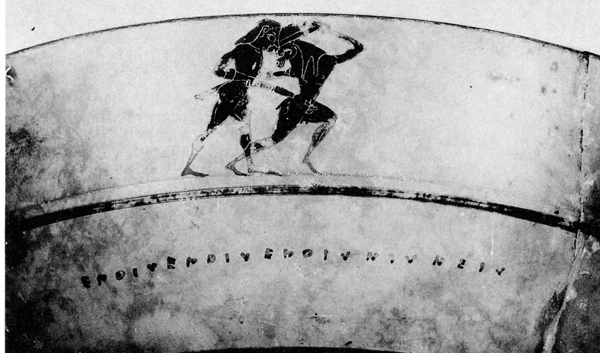

Greek vases of the archaic and classical period sometimes carry writing. The writing may be painted on the vase before firing (dipinti) or scratched on later (graffiti). In mythological scenes, the names of gods and heroes may be supplied. Sometimes words are written as if coming out of the mouth of a figure, suggesting what the figure is saying or singing. Another common type of inscribed message is ΚΑΛΟΣ or ΠΑΙΣ ΚΑΛΟΣ, "beautiful boy" (somewhat less common is ΚΑΛΗ, "beautiful girl"). The potter or the painter may also identify himself with "X made [this pot]" or "X painted [this pot]."
The Phoebe Apperson Hearst Museum of Anthropology has an extensive collection of Greek pottery, most of which is not on display. A few of these vases are reported to have writing on them (and these are the oldest samples of Greek writing on campus), but the writing is usually too faint to show up in the photographs published in Corpus Vasorum Antiquorum, USA fasc. 5, Univ. of California fasc. 1, by H. R. W. Smith in 1936. The most visible inscription is on a 6th-century Attic black-figure lip cup or kylix (inv. 8/358).

On both sides is a painting of Theseus stabbing the Minotaur. In the bands below the painted scenes, there are nonsense inscriptions.

On Side A above, the letters are ΕΠΟΙΥΕΠΟΙΥΕΠΟΙΥΝΣΥΝΕΣΥ, and the sequence is probably meant to remind a reader of a proper inscription of the form "so-and so" ΕΠΟΙΕΣΕΝ ("made"). Notice that the sigma has the so-called three-barred shape (the origin of Roman S) rather than the four-barred shape familiar in later inscriptions and in modern typefaces. Also, the upsilon is shaped more like V (the origin of the Roman U/V) than like Y in this early alphabet.

On Side B above, the letters are ΣΥΕΠΟΙΥΕΠΟΙΥΕΠΟΙΥΝΣΥ.